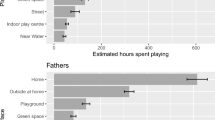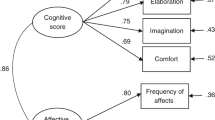Abstract
This study was designed to examine the underlying structure of the Children's Playfulness Scale (CPS). The CPS was administered to 602 children who were randomly divided into two groups (calibration and validation group). The calibration group (n= 279) included 137 boys and 142 girls, and the validation group (n= 323) included 162 boys and 161 girls, ranging in age from 4 to 6 years. A one-factor model was postulated and supported. According to the model, 5 variables measuring children's playfulness loaded on one factor (playfulness). In addition, the proposed model was found to be invariant across the two groups. Good cross-generalizability of the CPS appears to support its validity. Educators working in a preschool/kindergarten setting may use it with confidence when evaluating children's playfulness.
Similar content being viewed by others
REFERENCE
Arbuckle, J. L. (1997). AMOS users’ guide version 3.6. Chicago: Small Waters.
Barnett L.A. (1990). Playfulness: Definition, design, and measure-ment. Play & Culture, 3, 319–336.
Barnett L. A. (1991). The playful child: Measurement of disposition to play. Play & Culture, 4,51–74.
Barnett, L. A., & Kleiber, D. A. (1982). Concomitants of playfulness in early childhood: Cognitive abilities and gender. Journal of Ge-netic Psychology, 141, 115–127.
Barnett, L. A., & Kleiber, D. A. (1984). Playfulness and the early play environment. Journal of Genetic Psychology, 144, 153–164.
Bentler, P. M., & Bonett, D. G. (1980). Significance tests and good-ness of fit in the analysis of covariance structures. Psychological Bulletin, 88, 588–606.
Bollen, K. A. (1989). Structural equations with latent variables. New York: Wiley.
Byrne, B. M. (1994). Structural equation modelling with EQS and EQS/Windows: Basic concepts, applications and programming. Thousand Oaks, CA: Sage.
Byrne, B. M., Shavelson, R. J., & Muthén, B. (1989). Testing for the equivalence of factor covariance and mean structures: The issue of partial measurement invariance. Psychological Bulletin, 105, 456–466.
Cattell, R. B. (1979). Personality and learning theory: Vol. 1 The structure of personality in its environment. NewYork: Springer.
Corrigan, R. (1987).A developmental sequence of actor-object pretend play in young children. Merrill-Palmer Quarterly, 33(1), 87–106.
Hart, C., & Sheehan, R. (1986). Preschoolers’ play behaviour in out-door environments: Effects of traditional and contemporary play-consid-grounds.American Educational Research Journal, 23, 668–678.
Henniger, M. L. (1980). Free play behaviors of nursery school children in an indoor and outdoor environment. In P. F. Wilkinson (Ed.), In celebration of play(pp. 100–118). New York: St. Martin's Press.
Hu, L. T., & Bentler, P. M. (1995). Evaluating model fit. In R. H. Hoyle (Ed.), Structural equation modeling: Concepts, issues, and applications(pp. 76–99). Thousand Oaks, CA: Sage.
Kline, R. B. (1998). Principles and practice of structural equation modelling. New York: Guilford Press.
Krasnor, L. R., & Pepler, D. J. (1980). The study of children's play: Some suggested directions. In K. H. Rubin (Ed.), Children's play(pp. 85–96). San Francisco: Jossey-Bass.
Li, F., Harmer, P., Duncan, T. E., Duncan S. C., Acock, A., & Yama-moto, T. (1998). Confirmatory factor analysis of the task and ego orientation in sport questionnaire with cross-validation. Research Quarterly for Exercise and Sport, 69, 276–283.
Lieberman, J. N. (1965). Playfulness and divergent thinking: An inves-tigation of their relationship at the kindergarten level. Journal of Genetic Psychology, 107,29–224.
Lieberman, J. N. (1966).Playfulness: An attempt to conceptualise aqual-ity of play and of true player. Psychological Reports, 19, 1978.
Markland, D., Emberton, M., & Tallon, R. (1997). Confirmatory factor analysis of the subjective exercise experience scale among chil-dren. Journal of Sport and Exercise Psychology, 19, 418–433.
Mounts, N., & Roopnarine, J. (1987). Social-cognitive play patterns in same-age and mixed-age preschool classrooms. American Edu-cational Research Journal, 24, 463–476.
Parten, M. B. (1932). Social participation among preschool children. Journal of Abnormal and Social Psychology, 27, 243–269.
Piaget. J. (1962). Play, dreams, and imitation in childhood. New York: W.W. Norton.
Rogers, C. S., Meeks, A. M., Impara, J. C., & Frary, R. (1987). Mea-suring playfulness: Development of the child behaviors inventoryof playfulness. Paper presented at the Southwest Conference on human development, New Orleans, LA.
Roper, R., & Hinde, R. A. (1978). Social behavior in a playgroup: Consistency and complexity. Child Development, 49, 570–579.
Rubin, K. H. (1977). Play behaviors of young children. Young Chil-dren, 3,16–24.
Rubin, K. H. (1982a). Nonsocial play in preschoolers: Necessarily evil? Child Development, 53, 651–657.
Rubin, K. H. (1982b). Social and social-cognitive developmental char-acteristics of young isolate, normal, and sociable children. In K. H. Rubin & H. S. Ross (Eds.), Peer relationships and social skills in childhood. New York: Springer-Verlag.
Rubin, K. H., & Maioni T. L. (1975). Play reference and its relation-ship to egocentrism. Popularity, and classification skills in pre-schoolers. Merrill-Palmer Quarterly, 25, 171–179.
Rubin, K. H., Maioni, T. L, & Hornung, M. (1976). Free play behav-iors in middle-and lower-class preschoolers: Parten and Piaget revisited. Child Development, 47, 414–419.
Schwartzman, H. B. (1978). Transformations: The anthropology of children's play. New York: Plenum.
Singer, D. G., & Singer J. L. (1978). Some correlates of imaginative play in preschoolers. Paper presented at the meeting of the Amer-ican Psychology Association, Toronto, Ontario.
Singer, J. L., Singer, D. G., & Sherrod, L. R. (1980); A factor analytic study of preschooler's play behavior. American Psychology Bul-letin,2, 143–156.
Smilansky, S. (1968). The effects of sociodramatic play on disadvan-taged children: Preschool children. New York: Wiley.
Smith, P. K. (1978). A longitudinal study of school participation in preschool children: Solitary and parallel play reexamined. Developmental Psychology, 14, 517–523
Smith, P. K., Takhavar, M., Gore, N., & Vollstedt, R. (1985). Play in young children: Problems of definition, categorization, measure-ment. Early Child Development and Care, 19,25–41.
Tizard, B., Philps, H., & Plewis, I. (1976). Plan in preschool centers: II. Effects on play of the child's social class and of the educa-tional orientation of the center, Journal of Child Psychology & Psychiatry,17, 265–274.
Zachopoulou, E. (2002). Preliminary study of construct validity for the playfulness assessment scale in preschool children, Physical Activity & Quality of Life, 3,30–36.
Author information
Authors and Affiliations
Corresponding author
Rights and permissions
About this article
Cite this article
Trevlas, E., Grammatikopoulos, V., Tsigilis, N. et al. Evaluating Playfulness: Construct Validity of the Children's Playfulness Scale. Early Childhood Education Journal 31, 33–39 (2003). https://doi.org/10.1023/A:1025132701759
Issue Date:
DOI: https://doi.org/10.1023/A:1025132701759




